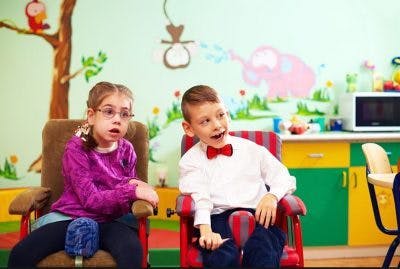When children with cerebral palsy have temper tantrums, it may be a sign of a deeper problem. Therefore, it’s essential to understand why children with cerebral palsy act out and how to promote more healthy and effective ways to communicate their feelings.
This article will discuss whether having cerebral palsy is related to having temper tantrums and how to effectively manage them.
Causes of Temper Tantrums in Children with Cerebral Palsy

Regardless of whether they have cerebral palsy or not, temper tantrums are completely normal in young children. Temper tantrums occur for a variety of reasons, including feeling frustrated, tired, hungry, or misunderstood. Often, temper tantrums have nothing to do with having CP and instead, are age-related and developmentally appropriate. However, about 25% of people with cerebral palsy have behavioral issues, which can contribute to frequent temper tantrums.
Cerebral palsy is caused by damage to the areas of the brain that affect motor skills like movement, balance, and posture. While cerebral palsy is not directly related to difficulties with emotional regulation, motor impairments can cause children to feel frustrated. This frustration can contribute to explosive temper tantrums.
For example, oral motor impairments can make it difficult for children with CP to talk and/or communicate their needs. This may result in them frequently being tired, hungry, or wanting something, but unable to have their needs met in a timely manner since those around them are unaware of these needs.
Similarly, children who have spasticity in the legs may be limited in their mobility and have difficulties participating in activities with their peers. This can be very emotionally challenging.
Additionally, associative conditions of cerebral palsy such as chronic pain, poor quality sleep, and learning disabilities may contribute to temper tantrums. Children with cerebral palsy can usually tell when they’re not understanding or doing things as quickly or as easily as those around them. As a result, they may act out because they feel different, misunderstood, and unaccepted.
Now that you understand the link between cerebral palsy and temper tantrums, let’s discuss ways to help your child better cope with their emotions.
How to Manage Cerebral Palsy Temper Tantrums

While a temper tantrum in a child is expected, a temper tantrum in a teen or adult is not typically developmentally appropriate and usually looked down upon. Furthermore, depending on the size of the individual and the intensity of the response, temper tantrums may be a safety concern for the individual and those nearby. Therefore, it’s ideal to address temper tantrums early and teach your child more effective ways to manage their emotions and communicate their feelings.
Below, we’ll go over mistakes to avoid and some of the most effective ways to manage temper tantrums in children with cerebral palsy.
1. Avoid Giving In
When your child throws a temper tantrum over not getting what they want, the worst thing to do is give in. Giving in only reinforces the idea that the child can get what they want by acting out. While it may quiet them down, you’re not addressing the underlying problem.
2. Behavioral Therapy
Children that continue to act out as they get older are often not developing the social skills necessary to effectively communicate their feelings and emotions.
Consider taking your child to a behavioral therapist to further work on developing social skills like:
- Problem-solving
- Controlling impulses
- Negotiating
- Social expectations
- Delayed gratification
Behavioral therapy will teach your child that there are better ways to cope with frustration than having a temper tantrum.
3. Time-Outs
Sometimes, you just need to take your child away from the situation causing the temper tantrum. Generally, children have short attention spans and will quickly get over what they were overreacting to if you take them out of the situation.
Calmly explain to your child why they are in a time-out and allow for an appropriate amount of quiet, alone time. Generally, the length of the time-out should be about one minute long per each year of age. With this guideline, a five-year-old would have about five minutes in time-out, while a three-year-old’s time-out would be about three minutes long. This will give them time to cool off and reflect on their own before returning to their activity.
4. Be Positive
Diverting your child’s attention away from what they can’t do and encouraging them to do things that they’re good at will help relieve frustration and boost confidence. Acknowledge and praise your child for positive behavior. This will help them distinguish the difference between good and bad behaviors.
5. Encourage Emotional Self-Regulation
Teaching children to find positive ways to deal with their emotions allows them to self-regulate. Emotional self-regulation is the ability to “check in” with yourself and use strategies to ensure your emotions and behavioral reactions are appropriate for the situation. This is ideal for older children, but even younger children can learn to better regulate their emotions with adult guidance.
A good first step for helping young children learn to manage their emotions is to work on simply labeling the emotions they are feeling. When children can name their emotions, they can more easily communicate and seek help to manage what they are feeling.
If your child feels as though they are getting close to having a temper tantrum, having some solid strategies to manage their emotions is essential.
Self-regulation strategies can include:
- Deep breathing with counting: Count as you take 5 deep breaths, breathing in through the nose like smelling flowers, exhaling out through the mouth like blowing out candles
- Self-hugging: Giving yourself a hug (or squeezing a pillow) provides deep pressure, calming the sensory systems and often emotions as well
- Take a break: Go to somewhere different and do a relaxing activity (coloring, listening to music, etc.)
Hopefully these steps can help manage developmentally inappropriate temper tantrums in individuals with cerebral palsy. Caregivers should try not to be hard on themselves if some temper tantrums continue as they can sometimes be developmentally appropriate depending on the individual.
Cerebral Palsy and Temper Tantrums: Key Points

Learning difficulties, motor impairments, and speech disorders can make it difficult for children with cerebral palsy to communicate. This can be very frustrating and result in temper tantrums.
While temper tantrums are typical in young children, they become less socially acceptable as the child gets older. By developing better social skills, reflecting on their actions, and focusing on things they’re good at, children with cerebral palsy can learn to better express and cope with their frustrations.











